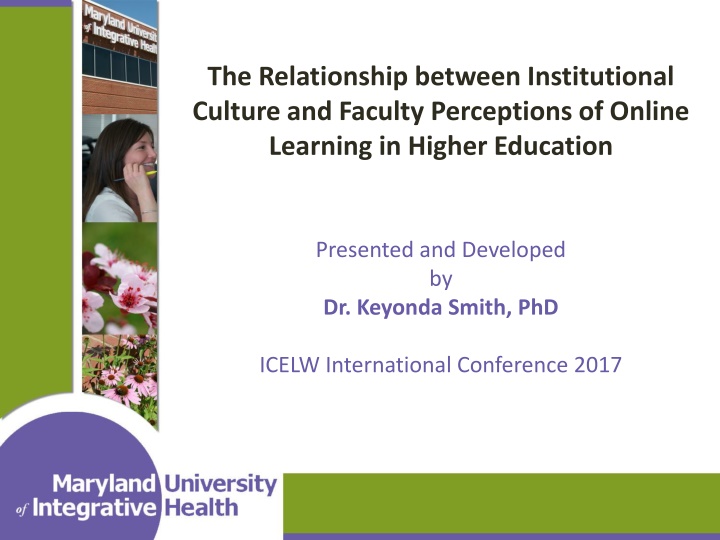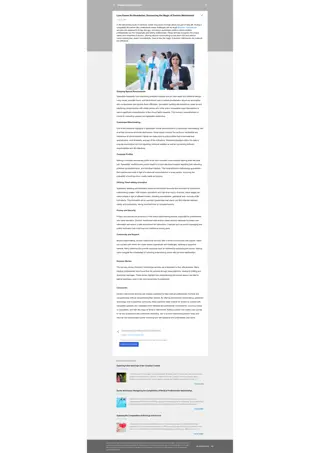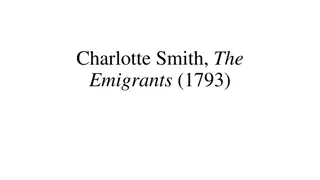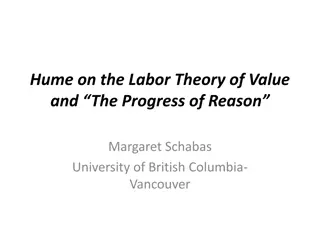
Exploring the Connection Between Institutional Culture and Faculty Perceptions of Online Learning
Dive into the research on how different institutional cultures impact faculty views on online learning in higher education. Discover the results, implications, and research methods utilized by Dr. Keyonda Smith at the ICELW International Conference.
Download Presentation

Please find below an Image/Link to download the presentation.
The content on the website is provided AS IS for your information and personal use only. It may not be sold, licensed, or shared on other websites without obtaining consent from the author. If you encounter any issues during the download, it is possible that the publisher has removed the file from their server.
You are allowed to download the files provided on this website for personal or commercial use, subject to the condition that they are used lawfully. All files are the property of their respective owners.
The content on the website is provided AS IS for your information and personal use only. It may not be sold, licensed, or shared on other websites without obtaining consent from the author.
E N D
Presentation Transcript
The Relationship between Institutional Culture and Faculty Perceptions of Online Learning in Higher Education Presented and Developed by Dr. Keyonda Smith, PhD ICELW International Conference 2017
Agenda Complete validated survey to determine attendee s institutional culture and online learning perceptions Describe research method and results Discuss participants survey results Implications for professional practice Wrap Up
Whats Your Culture? Let s first complete the Institutional Culture and Faculty Perceptions survey prior to delving into its implications: http://www.kmsmithphd.com/conference (select Resources/Presentation as circled below)
Original Research Question What is the relationship between institutions with collegium, bureaucracy, enterprise, and corporate culture typology and its faculty perceptions of online learning in higher education?
Research Method Correlational quantitative design
Research Method Correlational quantitative design Faculty of chiropractic higher education institutions
Research Method Correlational quantitative design Faculty of chiropractic higher education institutions G* power analysis recommends an approximate sample size of 118 with a 5% error rate.
Research Method Correlational quantitative design Faculty of chiropractic higher education institutions G* power analysis recommends an approximate sample size of 118 with a 5% error rate. Consent was obtained from survey developers. Survey items are Likert scaled and coded as: 5 = Strongly Agree 4 = Agree 3 = Neutral 2 = Disagree 1 = Strongly Disagree
Data Collection CCE accredited institutions were sent an invitation to participate. Upon approval from institutions and Trident s IRB committee, institutions were sent informed consent forms and a hyperlink to the survey, hosted by www.surveymonkey.com Responses were then exported into SPSS .
Data Collection Instrumentation
Data Collection Instrumentation Nauffal (2004) Institutional Culture Survey Reliability coefficient of = 0.9157 5-point Likert scale
Data Collection Instrumentation Nauffal (2004) Institutional Culture Survey Reliability coefficient of = 0.9157 5-point Likert scale
Data Collection Instrumentation (Continued) Totaro et al (2005) Faculty Perceptions of Distance Education Survey Pilot tested in 2 studies Reliability coefficient of = 0.8917
Data Collection Instrumentation (Continued) Totaro et al (2005) Faculty Perceptions of Distance Education Survey Pilot tested in 2 studies Reliability coefficient of = 0.8917
Results Coefficient Table for Faculty Perception of Online Learning with Collegium, Bureaucracy, Enterprise and Corporate Institutional Culture Variable 1 (Constant) Gender Age Category Race/Ethnicity Years Instructed at Current Institution Employment Status R2 F for change in R2 2 (Constant) Gender Age Category Race/Ethnicity Years Instructed at Current Institution Employment Status Collegium Bureaucracy Enterprise Corporate R2 F for change in R2 Note. Dependent Variable = Faculty Perception of Online Learning. **p < .01, *p < .05. Gender: 1=Male, 0=Female; Age Category: 0=31-50, 1=Over 50; Race/Ethnicity: 0=Non-white, 1=White; Years Instructed at Current Institution: 0=Less than 1 year, 1=1 or more years; Employment Status: 0=Part-Time, 1=Full-time. Change in R2 from Step 1 to Step 2 = .09. SE B .305 .143 .143 .200 .201 .173 .14** 3.78** .844 .149 .140 .198 .195 .172 .095 .129 .104 .082 .23* 3.22* t p B -.229 .005 -.256 -.020 .277 3.25 -.370 .007 -.545 -.044 .538 4.56 -.332 .006 -.425 -.036 .587 .069 -.411 -.012 -.034 10.66 -2.58 .052 -2.73 -.221 3.12 5.41 -2.23 .045 -2.15 -.183 3.42 .725 -3.18 -.114 -.419 .000 .011 .959 .007 .825 .002 .000 .028 .964 .034 .855 .001 .470 .002 .909 .676 -.206 .004 -.199 -.016 .303 .070 -.330 -.012 -.042
Results Coefficient Table for Faculty Perception of Online Learning with Collegium, Bureaucracy, Enterprise and Corporate Institutional Culture Variable 1 (Constant) Gender Age Category Race/Ethnicity Years Instructed at Current Institution Employment Status R2 F for change in R2 2 (Constant) Gender Age Category Race/Ethnicity Years Instructed at Current Institution Employment Status Collegium Bureaucracy Enterprise Corporate R2 F for change in R2 Note. Dependent Variable = Faculty Perception of Online Learning. **p < .01, *p < .05. Gender: 1=Male, 0=Female; Age Category: 0=31-50, 1=Over 50; Race/Ethnicity: 0=Non-white, 1=White; Years Instructed at Current Institution: 0=Less than 1 year, 1=1 or more years; Employment Status: 0=Part-Time, 1=Full-time. Change in R2 from Step 1 to Step 2 = .09. SE B .305 .143 .143 .200 .201 .173 .14** 3.78** .844 .149 .140 .198 .195 .172 .095 .129 .104 .082 .23* 3.22* t p B -.229 .005 -.256 -.020 .277 3.25 -.370 .007 -.545 -.044 .538 4.56 -.332 .006 -.425 -.036 .587 .069 -.411 -.012 -.034 10.66 -2.58 .052 -2.73 -.221 3.12 5.41 -2.23 .045 -2.15 -.183 3.42 .725 -3.18 -.114 -.419 .000 .011 .959 .007 .825 .002 .000 .028 .964 .034 .855 .001 .470 .002 .909 .676 -.206 .004 -.199 -.016 .303 .070 -.330 -.012 -.042
Your Institutional Culture (IC) What was the Institutional Culture of your organization? Your results may indicate its members perceptions of online innovation.
Survey Indications (handout) Bureaucracy: Decision-making is ruled based Style based on standard procedures Students are statistics University is the organizing unit Evaluation based on audit procedures Regulatory body sets standards Collegium: Decision-making is consensual Management style is permissive Students seen as apprentice academics Faculties main organizational units Evaluation is by peer review International community sets standards Enterprise: Corporate: Decision-making is political and tactical Style is charismatic and commanding Students are customers Focus on loyalty Standards related to institutional goals Centralized Control within the institution Predictors (Independent Variables) Decision-making flexible Style is one of devolved leadership Students are partners Project team dominating unit Evaluation based on achievement Standards related to market strength
Wrap Up Now that you know your IC, how does this inform change or innovation implementation? Based on your IC, what are some ways you can advance towards an enterprise culture? Questions, comments, suggestions? Contact Information: Dr. Keyonda Smith Director of Course Design Maryland University of Integrative Health Slide Deck Available: www.kmsmithphd/conferences Email: ksmith3@muih.edu






















